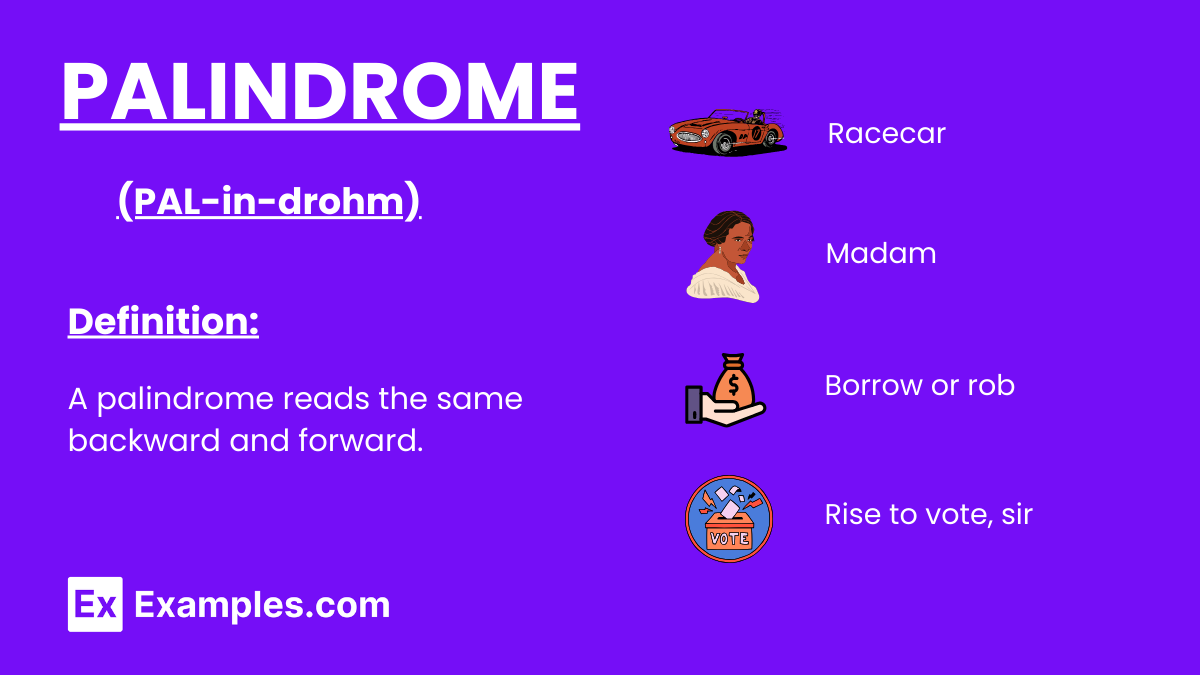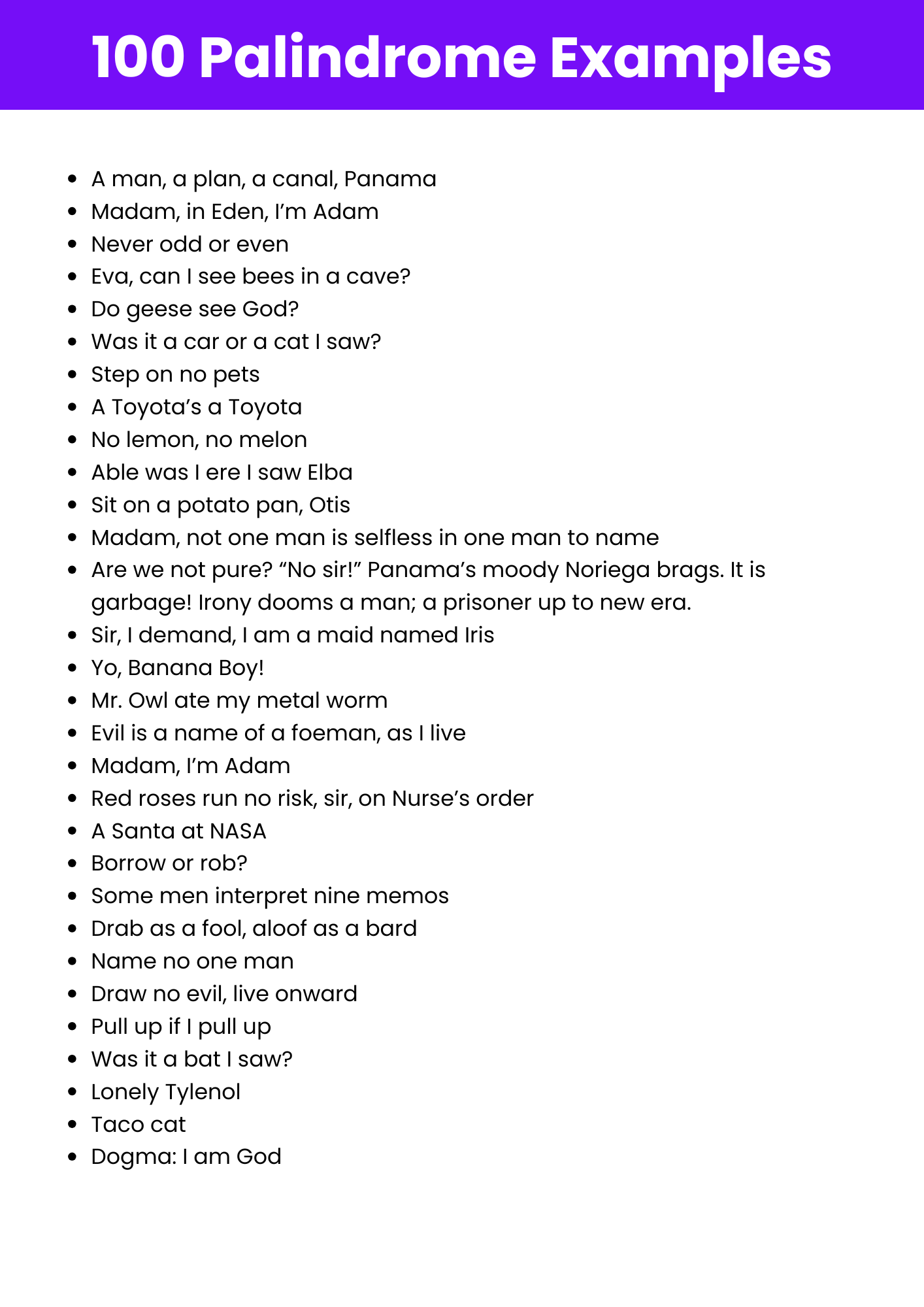Palindrome
What is Palindrome? – Definition
A palindrome is a word, phrase, number, or sequence of characters that reads the same forward and backward, ignoring spaces, punctuation, and capitalization.

Generated Palindrome Examples

Download Palindrome Examples
Enhance your understanding with our comprehensive PDF guide.
Download PDFExamples of Palindromes
- madam
- racecar
- level
- radar
- rotor
- civic
- deified
- refer
- wow
- noon
- A man, a plan, a canal, Panama
- Was it a car or a cat I saw?
- Able was I ere I saw Elba
- Evil is a name of a foeman, as I live.
- A Santa lived as a devil at NASA.
- Step on no pets.
- Evil rats on no star live.
- Never odd or even.
- Doc, note I dissent. A fast never prevents a fatness. I diet on cod.
- Eva, can I see bees in a cave?
- Dammit, I’m mad!
- Evil rats on no star live.
- A Toyota’s a Toyota.
- Yo, banana boy!
- Borrow or rob?
- Do geese see God?
- A dog! A panic in a pagoda.
- Sir, I demand, I am a maid named Iris.
- Yo, Bob, baby bo boy!
- Too hot to hoot.
Types of Palindromes
Word Palindromes
Single words that read the same backward as forward.
- madam
- level
- civic
- radar
- deified
Phrase Palindromes
Phrases that read the same backward, ignoring spaces, punctuation, and capitalization.
- A man, a plan, a canal, Panama
- Was it a car or a cat I saw?
- Step on no pets
- Never odd or even
- No lemon, no melon
Number Palindromes
Numerical sequences that read the same backward as forward.
- 121
- 12321
- 454
- 98789
- 1112111
Date Palindromes
Dates that are the same forward and backward.
- 02/02/2020
- 12/02/2021
- 11/11/1111
- 21/12/2112
- 01/01/1010
Sentence Palindromes
Entire sentences that read the same backward and forward, considering spaces and punctuation.
- Madam, in Eden I’m Adam.
- Evil is a name of a foeman, as I live.
- Was it a rat I saw?
- Do geese see God?
- Yo, banana boy!
Name Palindromes
Names that read the same backward as forward.
- Hannah
- Bob
- Anna
- Eve
- Otto
How to Identify a Palindrome?
Identifying a palindrome involves checking if a word, phrase, number, or sequence reads the same backward as forward. Ignoring spaces, punctuation, and capitalization can help spot palindromes in phrases or sentences.
- Check if the sequence reads the same backward and forward.
- Ignore spaces, punctuation, and capitalization for phrases and sentences.
- Analyze patterns in numbers or dates to see if they mirror themselves.
- Look for symmetry in the arrangement of letters or digits.
- Spot repetition or reversibility in words, phrases, or names.
How to Create a Palindrome?
Creating a palindrome involves designing a word, phrase, number, or sequence that reads the same backward as forward. Focus on symmetry and ensure the arrangement mirrors itself perfectly.
- Choose words or phrases with reversible letter arrangements.
- Experiment with symmetrical sequences of letters, numbers, or words.
- Use short, simple words to create meaningful phrases that mirror perfectly.
- Ensure the phrase retains its meaning when read backward.
- Incorporate repetition and symmetry to achieve balance and reversibility.
Other Palindrome Examples
Animal Palindromes
Names or terms related to animals that are palindromes.
- Civic
- Level
- Rotor
- Racecar
- Tenet
Musical Palindromes
Palindromes found in music, lyrics, or musical terms.
- Ma’am
- Noon
- Wow
- Sagas
- Anna
Emotional Palindromes
Words or phrases evoking emotions that are palindromes.
- Deed
- Evil live
- Eye
- Refer
- Kayak
Geographical Palindromes
Locations or terms from geography that are palindromes.
- Alula
- Navan
- Malayalam
- Ada
- Bob
Scientific Palindromes
Palindromes found in scientific terms or references.
- Rotor
- Stats
- DNA
- Racecar
- Radar
Nature Palindromes
Words and phrases inspired by nature that read the same backward and forward.
- Kayak
- Ewe
- Deed
- Level
- Solos
Explore Other Literary Devices
Elevate Your AP English Preparation
Unlock your potential with our comprehensive AP English exam preparation tools designed to help you excel.
- Extensive Question Bank: Access 900+ exam-like questions for both AP English Language and Literature.
- Expertly Crafted: Questions mirror the structure and difficulty of actual AP exams, ensuring relevant practice.
- Detailed Explanations: Understand your mistakes with clear, concise breakdowns of correct and incorrect answers.
- Personalized Learning: Tailor your study sessions with topic-specific tests and adaptive learning tools.
- Comprehensive Coverage: Master all aspects of the AP English curriculum with extensive guides and resources.
Frequently Asked Questions
-
What is a palindrome?
A palindrome is a word, phrase, number, or sequence that reads the same backward as forward, ignoring spaces, punctuation, and capitalization. -
What are some common examples of palindromes?
Common examples include words like “racecar,” “level,” and “madam,” and phrases like “A man, a plan, a canal, Panama.” -
Where are palindromes used?
Palindromes are used in literature, puzzles, word games, and even in mathematics and programming for fun or structural creativity. -
How do I identify a palindrome?
To identify a palindrome, read the word or sequence backward and check if it matches the forward reading, ignoring spaces and punctuation. -
Can numbers be palindromes?
Yes, numbers can be palindromes, such as 121, 12321, or 44444, as they read the same forward and backward. -
What is the longest palindrome in English?
One of the longest palindromic words in English is “tattarrattat,” coined by James Joyce, which represents the sound of a knock on a door. -
Are palindromes just words and phrases?
No, palindromes can also be sequences, like dates (e.g., 02-02-2020) or DNA sequences in genetics. -
How are palindromes used in programming?
In programming, palindromes are used in algorithms, coding challenges, and string manipulation tasks to test logic and understanding of sequences. -
Are there palindromes in other languages?
Yes, palindromes exist in many languages, including examples like “à révéler” in French and “anina” in Spanish. -
What makes palindromes special?
Palindromes are unique because they create symmetry and balance, making them intriguing and often used for artistic or intellectual play.

